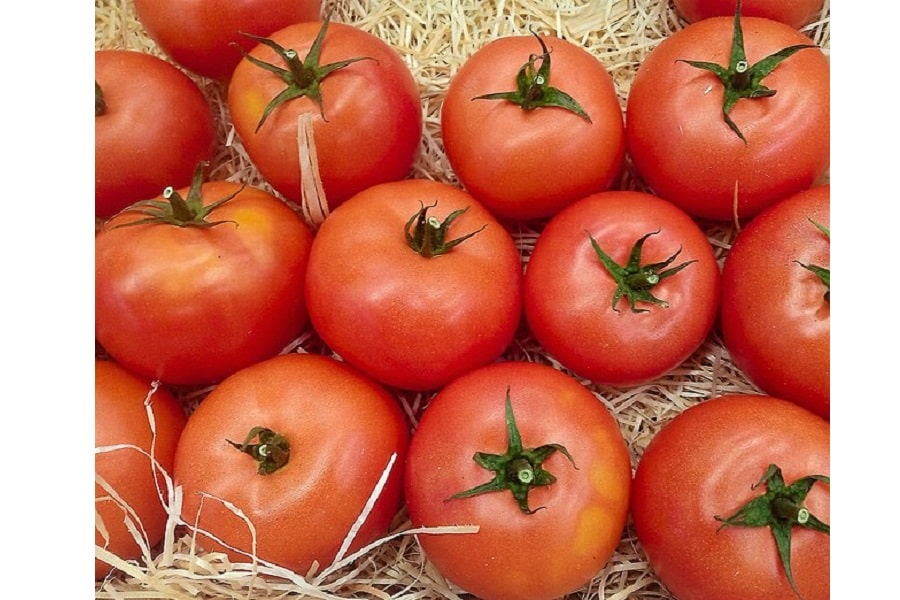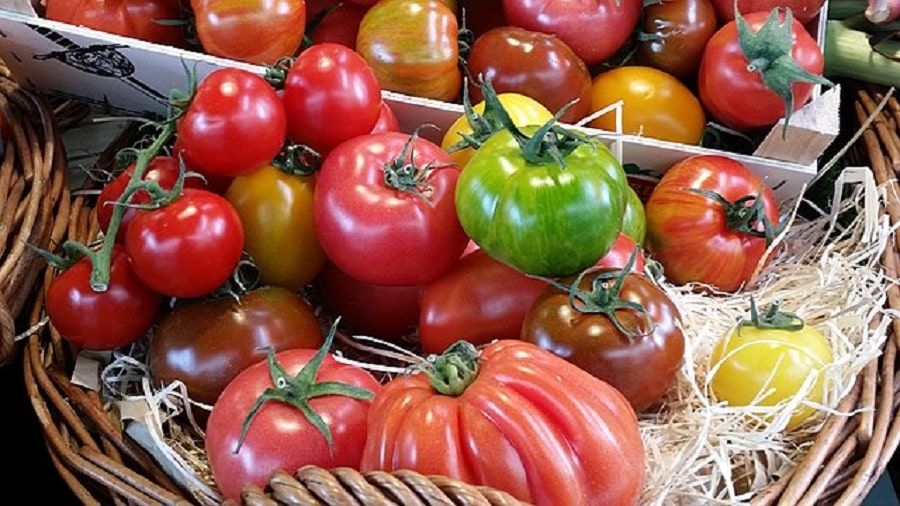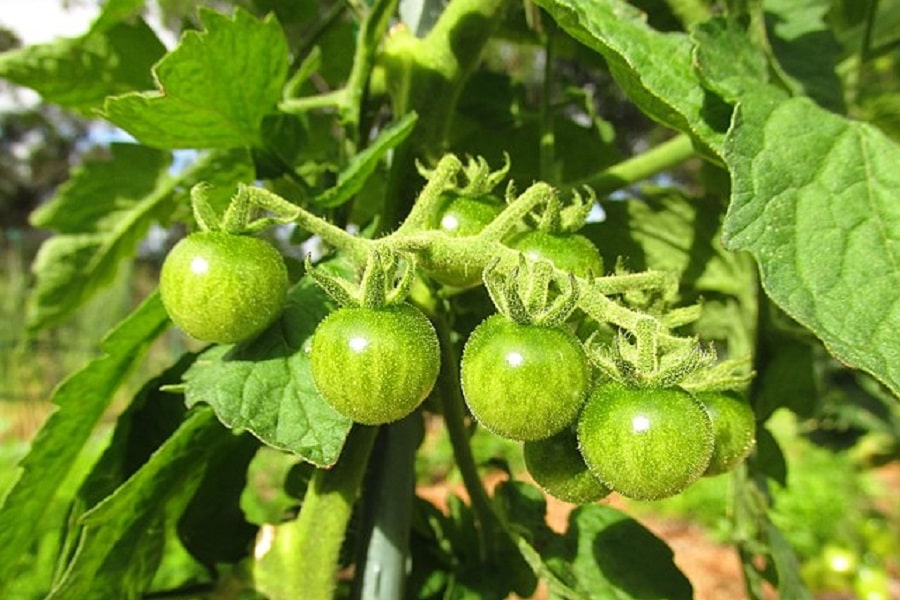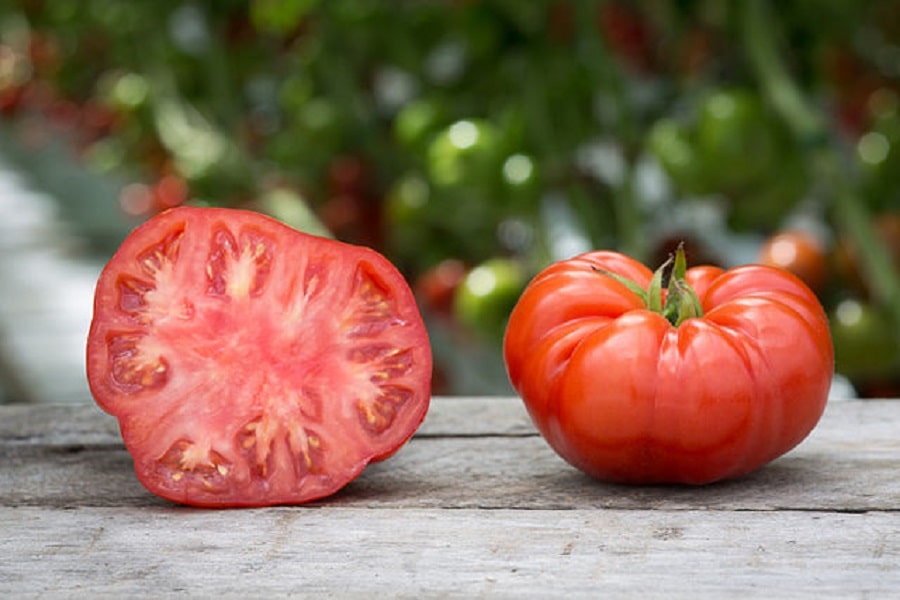The origin of tomatoes can be traced back to ancient Mesoamerica and the region of modern-day Mexico where it was first cultivated by indigenous peoples living here, such as the Aztecs and Mayans.
Today, tomatoes are one of the most popular and versatile fruits (or vegetables, depending on how you classify them) enjoyed by people all over the world. Whether sliced in a salad, transformed into a rich sauce, or juiced for a refreshing beverage, tomatoes have become a staple ingredient in countless cuisines.
Table of Contents
What is the Origin of Tomatoes?

The origin of tomatoes can be traced back to the ancient Mesoamerican civilizations, particularly in the region that is now modern-day Mexico. The indigenous peoples of this area, such as the Aztecs and Mayans, were among the first to cultivate and consume tomatoes [5].
Tomatoes belong to the Solanaceae family, which includes other plants like potatoes, peppers, and eggplants [2]. Wild tomatoes, known as Solanum pimpinellifolium, are believed to have originated in the coastal regions of western South America, specifically in present-day Peru and Ecuador. These wild tomatoes were small and round, with a yellow or red color [4].
The early domestication and cultivation of tomatoes by ancient Mesoamerican civilizations played a significant role in shaping their development. The indigenous peoples selectively bred tomatoes, leading to the emergence of larger and more varied tomato varieties. They cultivated different types, including red, yellow, and even purple tomatoes [4].
Tomatoes played a crucial role in the culinary traditions and religious practices of these ancient civilizations. They were used in various dishes, including sauces, stews, and soups [2]. Tomatoes were also offered as sacrifices to deities and used in rituals.
When Spanish explorers arrived in the Americas in the 16th century, they encountered tomatoes for the first time. The explorers were intrigued by this new fruit and brought tomato seeds back to Europe. Initially, tomatoes were primarily grown as ornamental plants in European gardens due to their vibrant colors [5].
READ MORE: Who Discovered America: The First People Who Reached the Americas
However, it took some time for tomatoes to gain acceptance as a food source in Europe; the European gardeners grew tomatoes as ornamental plants due to their vibrant colors. There were misconceptions and concerns about their potential toxicity. It wasn’t until the 18th century that tomatoes began to be widely consumed in Europe, especially in Mediterranean countries like Italy.
The popularity of tomatoes grew over time, and they eventually made their way to other parts of the world through colonization and trade routes. Today, tomatoes are cultivated in diverse climates and are a staple ingredient in countless cuisines worldwide [3]. They are used in a wide range of dishes, such as salads, pasta sauces, salsas, and even in beverages like tomato juice.
Examples of tomato varieties that have gained popularity include the beefsteak tomato, known for its large size and meaty texture, the Roma tomato, commonly used for sauces and canning, and cherry tomatoes, which are small and often used in salads or as a snack [2].
Which Country Found Tomatoes First? Early History and Discovery

The country that first discovered tomatoes is attributed to the ancient Mesoamerican civilizations, particularly the Aztecs and Mayans, in what is now present-day Mexico. These ancient civilizations were among the earliest cultivators and consumers of tomatoes. They recognized the potential of this fruit and began selectively breeding and cultivating different varieties [4].
The native peoples of Mesoamerica had diverse names for tomatoes in their respective languages. For example, the Aztecs referred to them as “xitomatl,” while the Mayans called them “tomatl.” These early cultivated tomatoes were smaller in size compared to modern varieties and had a wide range of colors, including red, yellow, and purple [5].
READ MORE: The Aztec Empire: The Rapid Rise and Fall of the Mexica
Are Tomatoes Native to America?
While tomatoes were first discovered and cultivated in Mesoamerica, they are not native to the entire American continent. Wild tomatoes, known as Solanum pimpinellifolium, originated in the coastal regions of western South America, specifically in present-day Peru and Ecuador. These wild varieties had small fruits with a yellow or red color [5].
The cultivation and domestication of tomatoes by Mesoamerican civilizations played a crucial role in transforming them into the fruit we recognize today. Through selective breeding, ancient farmers gradually developed larger and more diverse tomato varieties. These cultivated tomatoes spread throughout the Americas and became an essential part of the indigenous culinary traditions [3].
It is important to note that tomatoes were not known in Europe or other parts of the world until the arrival of Christopher Columbus and other Spanish explorers in the Americas. When the explorers encountered tomatoes for the first time, they were intrigued by their unique appearance and brought tomato seeds back to Europe [4].

Where Were Tomatoes First Grown? Cultivation and Spread
Tomatoes were first grown in the region of modern-day Mexico and Central America, which was inhabited by ancient Mesoamerican civilizations. The fertile lands of this area provided an ideal environment for tomato cultivation. The indigenous peoples of Mesoamerica, such as the Aztecs and Mayans, recognized the potential of tomatoes and began cultivating them as early as 700 AD [4].
The cultivation of tomatoes in Mesoamerica expanded across various regions. One notable site where tomatoes were grown is Tehuacán, located in present-day Mexico. Excavations at Tehuacán have revealed archaeological evidence of ancient tomato cultivation, including preserved tomato remains dating back thousands of years [5].
Ancient and Medieval Tomato Cultivation
The cultivation of tomatoes in ancient and medieval times involved different techniques and practices. In Mesoamerica, indigenous farmers developed sophisticated agricultural systems that allowed for efficient tomato cultivation. They used raised beds and irrigation channels to control water supply and manage the growth of tomato plants [5].
Ancient Mesoamerican civilizations recognized the importance of tomatoes not only as a food source but also for their symbolic and ritual significance. Tomatoes were often used in religious ceremonies and offerings to deities. They were considered sacred fruit and held a special place in the cultural and culinary traditions of the indigenous peoples [2].
READ MORE: Aztec Religion
Tomato Consumption Through History

When Did People Start Eating Tomatoes?
The exact timeline of when people started eating tomatoes is a topic of historical debate. While tomatoes were cultivated by ancient Mesoamerican civilizations, it is unclear whether they were consumed as a regular part of their diet [4]. Some theories suggest that early Mesoamerican cultures may have consumed tomatoes, while others propose that they were primarily used in religious rituals or as ornamental plants.
Initial Perceptions and Culinary Uses
The initial perceptions of tomatoes in Europe were shaped by their association with other plants in the nightshade family, some of which are toxic. This led to a belief that tomatoes might be harmful if ingested. As a result, tomatoes were primarily grown as decorative plants in European gardens rather than being used in cooking.
Over time, as the misconceptions about tomato toxicity began to fade, people started exploring the culinary uses of tomatoes. In Italy, the introduction of tomatoes into Italian cuisine revolutionized traditional dishes.
In addition to sauces, tomatoes were incorporated into various Mediterranean dishes. They were used in salads, soups, and stews, adding vibrant color and a unique flavor profile to the cuisine. The rich and tangy taste of tomatoes made them a versatile ingredient, enhancing the overall taste of dishes.
As tomatoes spread to other parts of the world, their culinary uses expanded further. In Mexico, tomatoes are a vital ingredient in salsas, guacamole, and other traditional dishes [3]. In the United States, tomatoes are widely used in sandwiches, burgers, and as a base for ketchup [2].
READ MORE: Who Invented the Sandwich and Where Did the Sandwich Come From?
Today, tomatoes are consumed in countless ways across different cultures and cuisines. They can be enjoyed fresh in salads, roasted for a smoky flavor, or cooked down into sauces and salsas. The versatility of tomatoes has made them a beloved ingredient worldwide [1].

Modern Cultivation and Varieties
Advancements in Tomato Cultivation Techniques
Modern tomato cultivation has witnessed significant advancements in techniques and technologies that enhance productivity and address various challenges faced by farmers. These advancements aim to improve yield, disease resistance, flavor, and overall quality of tomatoes [6].
One notable advancement in tomato cultivation is the introduction of greenhouse and hydroponic systems. Greenhouses provide controlled environments where temperature, humidity, and light can be optimized for optimal tomato growth. This allows year-round cultivation and protection against adverse weather conditions, pests, and diseases. Hydroponic systems, on the other hand, involve growing tomatoes without soil, with the plants receiving nutrients directly from a water-based solution. This method conserves water and allows for precise nutrient control, leading to higher yields and faster growth [6].
READ MORE: Who Invented Water? History of the Water Molecule
Additionally, breeding programs have focused on developing hybrid tomato varieties that possess desired traits such as disease resistance, extended shelf life, improved flavor, and uniformity in size and shape. These advancements have resulted in the availability of a wide range of tomato varieties suitable for different growing conditions, culinary uses, and consumer preferences [6].
Tomato Varieties and Their Characteristics
There are numerous tomato varieties cultivated worldwide, each with its own unique characteristics and culinary uses.
Beefsteak Tomatoes

These are large, juicy tomatoes with a meaty texture and rich flavor. They are commonly used in sandwiches, burgers, and salads [1].
Roma Tomatoes
Also known as plum tomatoes, Romas are oval-shaped with thick flesh and few seeds. They are ideal for making sauces, salsas, and canning due to their concentrated flavor and low moisture content.
Cherry Tomatoes
Cherry tomatoes are small, round, and sweet with a burst of flavor. They come in various colors, including red, yellow, and even black. Cherry tomatoes are often used in salads, as appetizers, or roasted for added sweetness [2].
Heirloom Tomatoes
Heirloom varieties are open-pollinated tomatoes that have been passed down through generations. They come in a wide array of shapes, sizes, and colors, and are known for their unique flavors and textures. Heirloom tomatoes are often prized for their historical significance and diverse culinary uses [1].
Cocktail Tomatoes
Cocktail tomatoes are slightly larger than cherry tomatoes but smaller than regular-sized tomatoes. They are versatile and commonly used in salads, skewers, and as a snack [3].
Indeterminate and Determinate Varieties
Tomatoes are classified into indeterminate and determinate types based on their growth habit. Indeterminate varieties continue to grow and produce fruit throughout the growing season, while determinate varieties have a more compact growth habit and produce fruit over a shorter period. The choice of indeterminate or determinate varieties depends on factors such as available space and desired harvest schedule [6].
These are just a few examples of the diverse tomato varieties available. Farmers, gardeners, and consumers can choose from a wide selection of tomatoes to suit their specific needs and preferences, ranging from size, shape, color, flavor, and culinary application [2].
References
- Goldman, A. (2008). The Heirloom Tomato: From Garden to Table: Recipes, Portraits, and History of the World’s Most Beautiful Fruit. Bloomsbury USA.
- Robinson, J. (2014). Eating on the Wild Side: The Missing Link to Optimum Health. Little, Brown and Company.
- Hart, S. (2010). Tomatoes: A Gardener’s Guide. Timber Press.
- Smith, A. F. (1994). The Tomato in America: Early History, Culture, and Cookery. University of South Carolina Press.
- Ibsen, G., & Nielsen, J. (1999). The Great Tomato Book. Ten Speed Press.
- Ross, J. D. (2018). The Tomato Handbook: For Modern Organic Farming. Routledge.